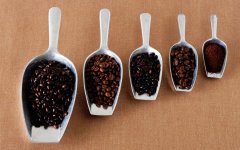The main producing areas of Galapagos Coffee introduce the boutique coffee producing area of San Cristobal.
The Galapagos Islands are about 300km from east to west and 200km from north to south (another source: 300km from north to south) and about 1000 km from the South American continent (about 1 hour and 30 minutes by air from Quito, Ecuador). It is a group of marine islands formed by lava deposits uplifted from the sea floor. The largest island in the archipelago is Isabella Island, which covers an area of 4588 square kilometers. In addition, there are more than 60 islands, such as St. Ruth Island and San Joaquin Island (another information: the Galapagos Islands is made up of 15 large islands, 42 small islands and 26 reefs). The total area of the archipelago is 8000 square kilometres (another source: 7800 square kilometers). 96.6% of the area is now a national park, surrounded by a marine protected area of 79.9 square kilometers.
The name of the archipelago "Galapagos" comes from the Spanish meaning of "Big Turtle". Far away from the mainland, the animals here have evolved with their own inherent characteristics.
These islands stand alone in the Pacific Ocean, and there are few freshwater resources on the island except Rain Water. It turned out to be some uninhabited island. In 1535, when a Panamanian ship was veered off course by a strong current, the bishop of Panama, Belanga, stumbled upon the archipelago and named the archipelago Lars Kantazens, meaning "fascinated". The island was uninhabited at that time. Fragments of Inca pottery were found on some islands, proving that the islands had been occupied before the Spaniards. (there is also information that says
Yes: in 1535, the Spaniards came here and found that the island was inhabited by a large number of giant turtles rarely seen in the world, so they named it "Galapagos Island", which means "Turtle Island".

Important Notice :
前街咖啡 FrontStreet Coffee has moved to new addredd:
FrontStreet Coffee Address: 315,Donghua East Road,GuangZhou
Tel:020 38364473
- Prev

The coffee produced in the three coffee-growing areas of Puerto Rico has a strong aromatic flavor.
Yaocote's choice of coffee, which is grown only on three farms in the southwest of the island, has a long aftertaste. This kind of coffee is very expensive and its flavor is comparable to that of any other coffee variety in the world. In the Yauco area, the coffee is owned and operated by local planters. The mountain climate here is mild, the plants have a long ripening period (from October to February), and the soil is of good quality.
- Next

Coffee Java, Sumatra (Blawan), Sulawesi (Sulawesi), Florida
Boutique coffee has a strict grading system. Generally, raw beans are preserved in parchment coffee beans in the form of endocarp after processing, and the endocarp is removed before export. Go through a strict grading process to ensure the uniformity of quality. And it is very important to preserve the protection in the process of transportation, such as the control of temperature and humidity, the control of ventilation, avoiding odor adsorption and so on.
Related
- Does Rose Summer choose Blue, Green or Red? Detailed explanation of Rose Summer Coffee plots and Classification in Panamanian Jade Manor
- What is the difference between the origin, producing area, processing plant, cooperative and manor of coffee beans?
- How fine does the espresso powder fit? how to grind the espresso?
- Sca coffee roasting degree color card coffee roasting degree 8 roasting color values what do you mean?
- The practice of lattes: how to make lattes at home
- Introduction to Indonesian Fine Coffee beans-- Java Coffee producing area of Indonesian Arabica Coffee
- How much will the flavor of light and medium roasted rose summer be expressed? What baking level is rose summer suitable for?
- Introduction to the characteristics of washing, sun-drying or wet-planing coffee commonly used in Mantenin, Indonesia
- Price characteristics of Arabica Coffee Bean Starbucks introduction to Manning Coffee Bean Taste producing area Variety Manor
- What is the authentic Yega flavor? What are the flavor characteristics of the really excellent Yejasuffi coffee beans?

